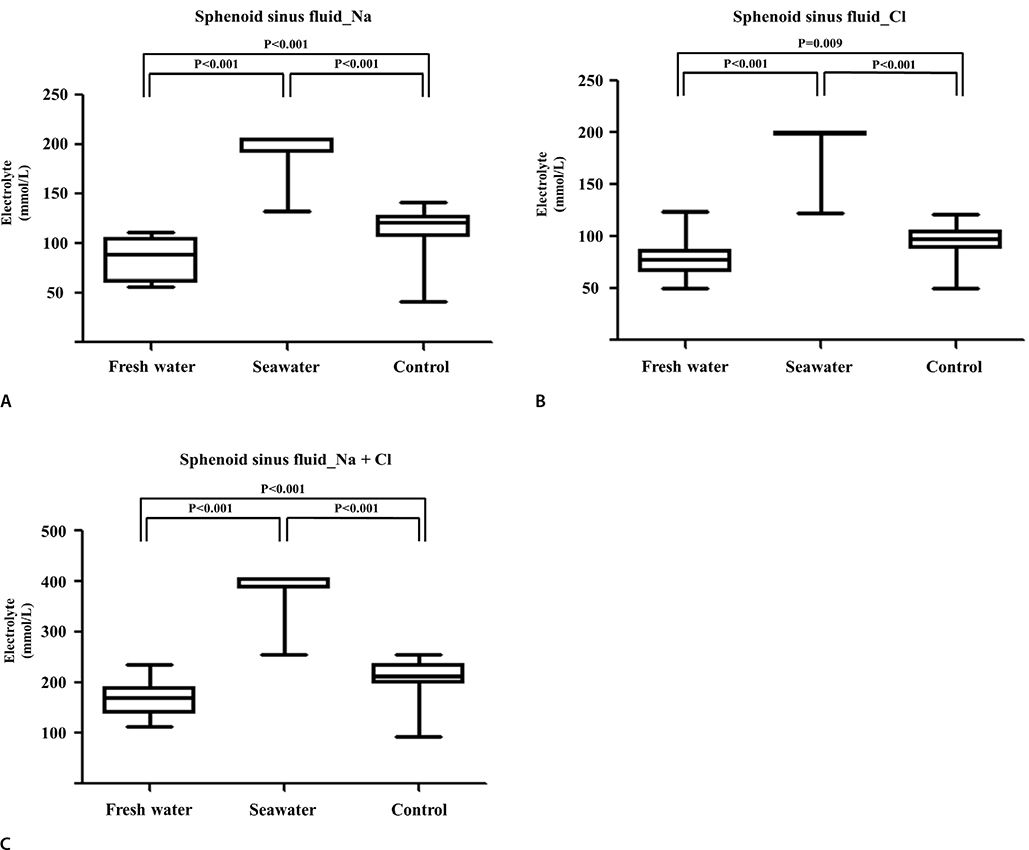Korean J Leg Med.
2019 Nov;43(4):129-137. 10.7580/kjlm.2019.43.4.129.
Evaluation of Sodium and Chloride Biochemical Tests in Drowning Autopsy Cases
- Affiliations
-
- 1Department of Pathology, Pusan National University Yangsan Hospital, Yangsan, Korea. pdrdream@gmail.com
- 2Medical Examiner's Office, National Forensic Service, Wonju, Korea.
- KMID: 2464490
- DOI: http://doi.org/10.7580/kjlm.2019.43.4.129
Abstract
- There are several diagnostic findings required for confirming a postmortem diagnosis of drowning. However, postmortem diagnosis of drowning remains challenging for forensic pathologists. In previous reports, several biochemical tests using various body fluids have been studied for their potential use in the postmortem diagnosis of drowning. In this study, the concentration of sodium and chloride was tested in various postmortem body fluids (vitreous humor, sphenoid sinus fluid, pleural fluid, cerebrospinal fluid, etc.) and their results were interpreted for their potential use in postmortem diagnosis of drowning. We examined 67 autopsy cases (freshwater drowning, 12 cases; seawater drowning, 16 cases; control group, 39 cases). The sodium and chloride concentration in the vitreous humor, sphenoid sinus fluid, and pleural fluid significantly correlated with each other. Furthermore, the concentrations of sodium, chloride, and the sum of the concentrations of the two in the various postmortem body fluids were significantly different in the three groups, when compared with each other (generally the concentration being the highest in the seawater drowning group, followed by the control group and the freshwater drowning group). Biochemical tests using various postmortem body fluids may serve as useful indicators for the postmortem diagnosis of drowning and for the differential diagnosis between freshwater and seawater drowning.
Keyword
MeSH Terms
Figure
Reference
-
1. Hayakawa A, Terazawa K, Matoba K, et al. Diagnosis of drowning: electrolytes and total protein in sphenoid sinus liquid. Forensic Sci Int. 2017; 273:102–105.2. Piette MH, De Letter EA. Drowning: still a difficult autopsy diagnosis. Forensic Sci Int. 2006; 163:1–9.3. Saukko P, Knight B. Knight's forensic pathology. 4th ed. Boca Raton: CRC Press;2015. p. 405–413.4. Zivkovic V, Babic D, Nikolic S. Svechnikov's sign as an indicator of drowning in immersed bodies changed by decomposition: an autopsy study. Forensic Sci Med Pathol. 2013; 9:177–183.5. Tse R, Garland J, Kesha K, et al. Combining postmortem vitreous sodium and chloride and lung-body ratio in aiding the diagnosing saltwater drowning. Am J Forensic Med Pathol. 2018; 39:229–235.6. Matoba K, Murakami M, Hayakawa A, et al. Application of electrolyte analysis of pleural effusion to diagnosis of drowning. Leg Med (Tokyo). 2012; 14:134–139.7. Yajima D, Saito H, Sato K, et al. Diagnosis of drowning by summation of sodium, potassium and chloride ion levels in pleural effusion: differentiating between freshwater and seawater drowning and application to bathtub deaths. Forensic Sci Int. 2013; 233:167–173.8. Garland J, Philcox W, Kesha K, et al. Elevated cerebrospinal fluid sodium and chloride levels in a saltwater drowning death. Am J Forensic Med Pathol. 2019; 40:258–261.9. Garland J, McCarthy S, Hensby-Bennett S, et al. Elevation of postmortem cerebrospinal fluid sodium and chloride levels is a potential adjunct test in the diagnosis of salt water drowning. Am J Forensic Med Pathol. 2019; 40:251–257.10. Paulis MG, Hasan EI. Electrolytes and biochemical changes in cerebrospinal fluid in drowning: experimental rabbit model. Am J Forensic Med Pathol. 2018; 39:236–241.11. Cala AD, Vilain R, Tse R. Elevated postmortem vitreous sodium and chloride levels distinguish saltwater drowning (SWD) deaths from immersion deaths not related to drowning but recovered from saltwater (DNRD). Am J Forensic Med Pathol. 2013; 34:133–138.12. Anne S, Tse R, Oldmeadow C, et al. Immersion of bovine eyeballs after 1 hour in seawater does not result in elevation of postmortem vitreous humor sodium and chloride levels. Am J Forensic Med Pathol. 2016; 37:108–111.13. Garland J, Tse R, Oldmeadow C, et al. Elevation of post mortem vitreous humour sodium and chloride levels can be used as a reliable test in cases of suspected salt water drowning when the immersion times are less than one hour. Forensic Sci Int. 2016; 266:338–342.
- Full Text Links
- Actions
-
Cited
- CITED
-
- Close
- Share
- Similar articles
-
- The Significance of Fluid in the Sphenoid Sinuses in Death by Drowning
- Effect of Sodium Chloride on Biology of Catenaria anguillulae
- Comparison of Pathologic Findings by Seawater or Fresh Water Drowning on the Experimental Animals
- Analysis of Diatom Detection Result for Immersed Bodies in Honam Area in 2008
- Application of Green Algae Habitating along the Streams in Chungju Province onto the Diagnosis of Drowning






